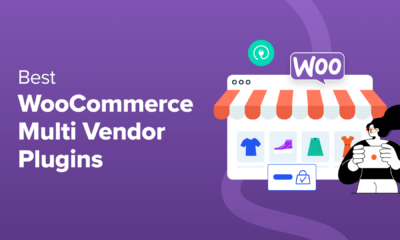SOCIAL
Twitter Tweaks Requirements for Creator Ad Revenue Share Program

As Twitter continues its transition to X, it’s also evolving its creator ad revenue share program, which recently saw a range of creators get some big first payouts from the platform.
As a reminder, Twitter’s ad revenue share program is available to all Twitter Blue subscribers who are generating significant engagement on the platform.
In its original iteration, the requirement was that creators had to have generated at least 5 million tweet impressions per month, for three consecutive months, in order to qualify, but according to new reports, Twitter’s actually revising this, and a few other elements of the program, to better enable Blue subscribers to earn cash from their tweets.
According to reports, the new requirements for the updated program will be:
- Account must be subscribed to Twitter Blue and have payouts switched on
- Account must have generated 15 million cumulative impressions over the preceding three months
That’ll enable more creators to make it into the program, even if they have a down month in the period, as their cumulative engagement will now be taken into account, as opposed to month-on-month figures.
The minimum monthly payout amount for the program will be $50, and creators will soon no longer have to have Subscriptions turned on to receive payments, though you will have to have payouts activated, and a connected Stripe account.
Also, interestingly, Twitter/X seems to be moving away from its previously stated requirement that ‘content must be original, and not mostly re-posts of other content’.
Twitter owner Elon Musk made a specific statement about this, noting that:
Anyone engaging in repeated theft of posts be demonetized
— Elon Musk (@elonmusk) July 14, 2023
But in more recent iterations of the ad revenue share splash screen, this element has seemingly been removed from the listing of considerations for the program.
That could be because some of the highest-earning accounts do actually re-post a lot of content, while Elon himself is also notorious for re-sharing other people’s memes without credit.
Maybe that softened Twitter’s stance on this element, or maybe they just can’t enforce it, but now this seemingly won’t be as big a consideration as Twitter had initially suggested.
So, to get paid to tweet, you just need 15 million cumulative engagements over three months, and to be subscribed to Twitter Blue. I mean, that’s a lot of engagement, but it could provide another pathway to making money from your Twitter presence.
Though the incentive structure remains problematic.
As an example, a recent trend that’s been getting a lot of attention online is NPC live-streaming, which sees people streaming as a character that responds to stickers posted during the broadcast.
That’s come about because for each sticker that’s submitted, the streamer earns direct revenue, so these creators have worked out how to maximize these stickers as an earnings element, thereby getting them more cash per stream.
Once you put an incentive structure in place (i.e. stickers = money) creators will come up with ways to feed into that specific driver, and Twitter’s creator revenue share program directly incentivizes creators to prompt as many replies as possible, in order to earn money from the ads shown in the reply stream.
Not only that, but only verified ad views count, and many verified Twitter users are politically aligned with Elon Musk’s free speech push at the app.
As such, the best way to prompt maximum replies to your tweets is likely via divisive hot takes, especially on issues that are of particular interest to verified users. So free speech, COVID vaccines, Tesla, political hot-button debates, all of these are likely to drive more response, with the system effectively pushing users to share more content on these specific elements.
Will that improve the user experience? Probably not. I suspect that, over time, non-verified users will be more and more alienated by this push, which could actually open the door for Meta’s Threads app to gain more traction, and become a bigger competitor for the app. Previous research has also shown that, in the majority, most people don’t want angry political discussion to take over their social media experience, which is why Meta’s looking to actively step away from such.
But Twitter/X is moving towards it. Which might not end up being the winning strategy Elon and Co. think, while the engagement thresholds will also lock out many users, and see many that just meet them earning tiny amounts, for a lot of effort.
Providing more ways for creators to make money is undoubtedly a good thing, but it feels like this particular incentivization could end up becoming a problem for Elon and crew.
But we’ll find out. Twitter’s expected to release its updated ad revenue share requirements shortly.
SOCIAL
Snapchat Explores New Messaging Retention Feature: A Game-Changer or Risky Move?

In a recent announcement, Snapchat revealed a groundbreaking update that challenges its traditional design ethos. The platform is experimenting with an option that allows users to defy the 24-hour auto-delete rule, a feature synonymous with Snapchat’s ephemeral messaging model.
The proposed change aims to introduce a “Never delete” option in messaging retention settings, aligning Snapchat more closely with conventional messaging apps. While this move may blur Snapchat’s distinctive selling point, Snap appears convinced of its necessity.
According to Snap, the decision stems from user feedback and a commitment to innovation based on user needs. The company aims to provide greater flexibility and control over conversations, catering to the preferences of its community.
Currently undergoing trials in select markets, the new feature empowers users to adjust retention settings on a conversation-by-conversation basis. Flexibility remains paramount, with participants able to modify settings within chats and receive in-chat notifications to ensure transparency.
Snapchat underscores that the default auto-delete feature will persist, reinforcing its design philosophy centered on ephemerality. However, with the app gaining traction as a primary messaging platform, the option offers users a means to preserve longer chat histories.
The update marks a pivotal moment for Snapchat, renowned for its disappearing message premise, especially popular among younger demographics. Retaining this focus has been pivotal to Snapchat’s identity, but the shift suggests a broader strategy aimed at diversifying its user base.
This strategy may appeal particularly to older demographics, potentially extending Snapchat’s relevance as users age. By emulating features of conventional messaging platforms, Snapchat seeks to enhance its appeal and broaden its reach.
Yet, the introduction of message retention poses questions about Snapchat’s uniqueness. While addressing user demands, the risk of diluting Snapchat’s distinctiveness looms large.
As Snapchat ventures into uncharted territory, the outcome of this experiment remains uncertain. Will message retention propel Snapchat to new heights, or will it compromise the platform’s uniqueness?
Only time will tell.
SOCIAL
Catering to specific audience boosts your business, says accountant turned coach

While it is tempting to try to appeal to a broad audience, the founder of alcohol-free coaching service Just the Tonic, Sandra Parker, believes the best thing you can do for your business is focus on your niche. Here’s how she did just that.
When running a business, reaching out to as many clients as possible can be tempting. But it also risks making your marketing “too generic,” warns Sandra Parker, the founder of Just The Tonic Coaching.
“From the very start of my business, I knew exactly who I could help and who I couldn’t,” Parker told My Biggest Lessons.
Parker struggled with alcohol dependence as a young professional. Today, her business targets high-achieving individuals who face challenges similar to those she had early in her career.
“I understand their frustrations, I understand their fears, and I understand their coping mechanisms and the stories they’re telling themselves,” Parker said. “Because of that, I’m able to market very effectively, to speak in a language that they understand, and am able to reach them.”Â
“I believe that it’s really important that you know exactly who your customer or your client is, and you target them, and you resist the temptation to make your marketing too generic to try and reach everyone,” she explained.
“If you speak specifically to your target clients, you will reach them, and I believe that’s the way that you’re going to be more successful.
Watch the video for more of Sandra Parker’s biggest lessons.
SOCIAL
Instagram Tests Live-Stream Games to Enhance Engagement

Instagram’s testing out some new options to help spice up your live-streams in the app, with some live broadcasters now able to select a game that they can play with viewers in-stream.
As you can see in these example screens, posted by Ahmed Ghanem, some creators now have the option to play either “This or That”, a question and answer prompt that you can share with your viewers, or “Trivia”, to generate more engagement within your IG live-streams.
That could be a simple way to spark more conversation and interaction, which could then lead into further engagement opportunities from your live audience.
Meta’s been exploring more ways to make live-streaming a bigger consideration for IG creators, with a view to live-streams potentially catching on with more users.
That includes the gradual expansion of its “Stars” live-stream donation program, giving more creators in more regions a means to accept donations from live-stream viewers, while back in December, Instagram also added some new options to make it easier to go live using third-party tools via desktop PCs.
Live streaming has been a major shift in China, where shopping live-streams, in particular, have led to massive opportunities for streaming platforms. They haven’t caught on in the same way in Western regions, but as TikTok and YouTube look to push live-stream adoption, there is still a chance that they will become a much bigger element in future.
Which is why IG is also trying to stay in touch, and add more ways for its creators to engage via streams. Live-stream games is another element within this, which could make this a better community-building, and potentially sales-driving option.
We’ve asked Instagram for more information on this test, and we’ll update this post if/when we hear back.
-

 SEO7 days ago
SEO7 days agobrightonSEO Live Blog
-

 SEO5 days ago
SEO5 days agoGoogle March 2024 Core Update Officially Completed A Week Ago
-

 WORDPRESS6 days ago
WORDPRESS6 days ago9 Best WooCommerce Multi Vendor Plugins (Compared)
-

 MARKETING4 days ago
MARKETING4 days agoNavigating the Video Marketing Maze: Short-Form vs. Long-Form
-
SEARCHENGINES6 days ago
Daily Search Forum Recap: April 25, 2024
-
![The Current State of Google’s Search Generative Experience [What It Means for SEO in 2024] person typing on laptop with](https://articles.entireweb.com/wp-content/uploads/2024/04/The-Current-State-of-Googles-Search-Generative-Experience-What-It.webp-400x240.webp)
![The Current State of Google’s Search Generative Experience [What It Means for SEO in 2024] person typing on laptop with](https://articles.entireweb.com/wp-content/uploads/2024/04/The-Current-State-of-Googles-Search-Generative-Experience-What-It.webp-80x80.webp) MARKETING5 days ago
MARKETING5 days agoThe Current State of Google’s Search Generative Experience [What It Means for SEO in 2024]
-

 SEO6 days ago
SEO6 days agoGoogle Declares It The “Gemini Era” As Revenue Grows 15%
-

 SEARCHENGINES5 days ago
SEARCHENGINES5 days agoGoogle March 2024 Core Update Finished April 19, 2024











